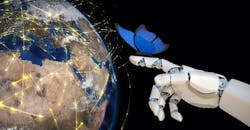The Butterfly Effect: Digital Transformation Gives Manufacturers a Nimble New Look
Capgemini is credited with coining the phrase "digital transformation" for manufacturing in its 2011 Digital Transformation Review, but they really just put a name to something that had been going on since the 1940s and the birth of digital computing. From the biggest industries all the way down to businesses and even the individual, computers have been transforming the way we get at our money, schedule our lives and how we communicate. "Transformation" isn’t quite apropos to what is going on now. With how the benefits of the cloud, artificial intelligence, Industry 4.0 and blockchain are already impacting plants and factories on every level, the more correct term may be digital metamorphosis.
A transformation doesn’t necessarily mean change for the better, and that's what many manufacturing leaders are worried about: they’ll invest in all this new hardware, the integration, the training—and realize they just replaced problems they knew how to manage with ones they have to wait for some third-party vendor or contractor to fix.
Now, going through a metamorphosis implies the company realize their caterpillar-like shortcomings, like being too slow and nibbling on the same old leaf. The concerted effort to become more digital signifies that they choose to become more like a quick and nimble butterfly. It's an oftentimes laborious, resource-intensive process, but one that results in new abilities, like being able to rise above the dense foliage and pick out the best customers and suppliers.
A lot of Hala Zeine's job as president of SAP's digital supply chain is to convince manufacturing leaders that this can be their reality, particularly when it comes to their logistics and inventory.
"I do feel the whole movement of digitalizing the supply chain is really going to remove stress for these people in these jobs," she says, referring to the shop floor leaders, plant manager and others working with ERP systems.
Zeine believes that stress is caused by the 90% of time sorting through data and figuring out where things, leaving a scant 10% to make creative and possibly disruptive management decisions. That's probably a worst-case imbalance, but if you're not yet spending 100% of your time using your data to better your operations, you could use some incremental improvements.
The example that often springs to mind is adding more sensors to equipment, on trucks or in storage containers—the nets with which to trap all that environmental data. (For a look at several companies already doing this, check out these nine smart factories.) But as important as the machines are, Zeine says not to forget about the human factor, which is also strengthened through connecting embedded sensors on gloves or other wearables to the ERP.
"We’re having a lot of worker safety innovation we could not have done before," she says. New insights from the data could even save workers from injury or hearing loss or improve quality.
"If you know you've scheduled a worker in a really loud place, you may not want to schedule them repetitively, because it may harm them," she says. "And in a glove, [location sensors indicate] hand position and tell you if they were in the wrong position and tightened the wrong screw, which could affect product quality."
Building Up a Strategy
The concept of metamorphosis is an appealing prospect, but there is that pesky cocoon stage to contend with. In between deciding to digitally transform a production line or process and seeing the beautiful ROI from slashing inefficiencies, you're left hanging. Just waiting. Vulnerable. Resources and time spent you can;t get back. Praying you're not a casualty of the hype.
And there are casualties. The World Economic Forum recently revealed that 70% of initiatives in AI, big data and other advanced digital technologies fail. And an IFS study found only 16% of its 200 manufacturers surveyed had connected their IoT data to their ERP software.
Zeine says one of the issues is getting IT and OT on the same page. That's hard to do when leadership doesn’t set clear, definable parameters for the project.
"If you say we want to do Industry 4.0 because everyone else is, then it is hard, because no one understands why you're doing this," she says.
It's understandable that an executive would mandate an IoT project get off the ground, but it's what you want the data to do for you that matters. SAP says 90% of all the world's data has been created in last two years. Whatever share your equipment and workers contribute to that massive till should always add value to your company. Going back to the butterfly analogy, they don’t have strikingly colorful wings just to look pretty. These ornate patterns and vibrant hues communicate something to potential mates and/or predators. Your data should ultimately tell something to your customers or provide an edge against competitors.
It doesn’t have to be major, but it should affect positive change.
"That's why I like the supply chain: everything is KPI driven," Zeine says. "It becomes an outcome driven discussion. Then you rally your people and then get the technology to support that outcome. Then you can measure it."
For a machine shop that routinely misses orders, the reason may be due to equipment downtime. In this case, adding some predictive maintenance to the CNC machines can give shop floor managers more room to, you know, manage, as opposed to react. That helps unsettle the 90/10 imbalance of reaction vs. action Zeine spoke of.
"When the OT data connects with the IT data, that when the magic starts to form," Zeine says. "You get that total visibility that's happening on the shop floor."
Having more data also means knowing more potential outcomes. You can simulate how that data would affect the supply chain. If you change suppliers, or take down a line for a day, how does that affect the other links downstream?
Zeine says using these simulations and the Leonardo platform, SAP customers such as HP, Jaguar and LandRover have been able to reduce lead times, significantly in some instances, from 21 days to six hours.
Better Through Blockchain
The newest component of the digital metamorphosis, the tie that binds together the IIoT, your ERP, your product, your workers, and customers, is blockchain. SAP began its own pilot projects (40 in total with 85 customers) into the technology last year, and Zeine's eyes lit up when the subject was mentioned, as if to say "Finally!"
She says blockchain—the decentralized, secure way to store data popularized by cryptocurrency—can extend the power of your ERP and the traceability it provides out to OEMs, customers and suppliers.
"The moment you leave your own space that traceability is gone," she says. "Blockchain has the power to give that traceability back. Now you can work with others on a similar system and have it all be locked in very securely. You think of contracts being exchanged. Any change can be exactly monitored."
Within a business's firewall-protected network, this already happens. Growing this out into your supply ecosystem allows for ultimate visibility, that butterfly's eye view of every detail before materials enter the factory and what happens to the finished product after.
For farm to fork operations, arguably civilization's oldest production network, blockchain provides a near-omniscient level of understanding. This was touched upon by one of SAP's pilots involving J.R. Simplot, Johnsonville, Maple Leaf Foods and Naturipe Farms, a century-old company that grows Fair Trade berries. SAP's project tracked all the ingredients of a chicken Caesar salad from the poultry, cheese and lettuce to cherries and blueberries (though why anyone put the last two on a Caesar salad is anyone's guess).
Each member pooled pallet serialization and ingredient data into one ledger, so each could be assured the chicken originated from where it was claimed to be from.
For farms that say they are organic, blockchain offers a new level of transparency and accountability, which go hand-hand with traceability. Reviewing the records, which can still keep some proprietary info hidden where appropriate, allows the receiver of produce to know if fertilizer or chemicals compromised a shipment of apples, Zeine says.
Health and safety are also improved, as e. Coli outbreaks could also be traced to the source much quicker. Furthermore, the sensor data from the refrigerated shipping trucks get fed into the system, so if there is a discrepancy in temperature, the orange juice maker would be able to prevent using a contaminated batch.
What about more complex products? Zeine says the technology exists to search for specific materials.
"Let's say you have a plastic called P36, and someone finds out P36 is carcinogenic," Zeine hypothesizes. "Do I have P36 in my supply chain?"
Taking this a step further, a company can verify country of origin for materials. If they don’t want to be involved with a nation that commits human rights abuses, a company can perform a search to see if a bad actor contributes to their supply chain. They can also run simulations to see how much more it would cost to switch to another source and what the new projected revenue and margins would be.
It's hard to predict why any specific link in the supply chain might want a datum, but the important thing is that now they can. They can track from when the tiny butterfly in the system flaps its wings to the big ramifications that can have.
"You can bring in a customer request and really play it out through the whole supply chain, without costing too much because the system's intelligence can take over," Zeine says.
About the Author
John Hitch
Senior Editor
John Hitch writes about the latest manufacturing trends and emerging technologies, including but not limited to: Robotics, the Industrial Internet of Things, 3D Printing, and Artificial Intelligence. He is a veteran of the United States Navy and former magazine freelancer based in Cleveland, Ohio.
Questions or comments may be directed to: [email protected]




